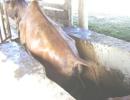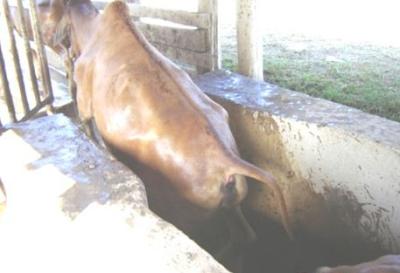
|
Disease Prevention
|
| Introduction | Quarantine/Livestock Movement Control | |||
| Prevention of tick borne disease | Review Process / Contact | |||
| Vaccination of animals |
Introduction
Prevention of diseases is always both better and cheaper than treatment. Even if vaccines and other preventive measures may seem expensive, they are in the long run much cheaper than loosing animals or letting animals loose condition and buying expensive drugs - not to mention the fees of the vets!
The following public and private disease prevention also protects the rights of the animals to a worthy enjoyable life and are the pillars of good and successful (and profitable) management.
The following public and private disease prevention also protects the rights of the animals to a worthy enjoyable life and are the pillars of good and successful (and profitable) management.
Prevention of tick borne disease
Above picture shows a typical cattle dip, preventing insect and particularly tick borne diseases, by letting the animals jump into a dip filled water with added acaricide (tick poison). Prevention of tick borne diseases is by spraying, dipping or using Pour-on chemicals to get rid of the ticks
Vaccination of animals
Introduction
Very many animal diseases are preventable by vaccination and scientists are constantly searching for new vaccines to manage diseases.
Only healthy animals should be vaccinated, because weak animals will not respond effectively. Some weak animals can even become sick from the vaccines.
Vaccines take a minimum of 2 weeks or more to take good effect.
Do not use antibiotics and other drugs in connection with vaccines, as they may interfere with the protective effects of the vaccine.
Try to avoid disinfectants during vaccinations. Use sterilization by boiling water or use new disposable needles.
Avoid using chlorinated water when giving chicken oral vaccines. Use rain water, spring water or borehole water - but NOT Chlorinated water.
When using live vaccines some animals may develop mild symptoms of the disease. This is no cause for alarm, as it shows the vaccine is working.
Vaccination practices
- Ring vaccination: This is the practice of vaccinating all neighbouring animals in areas of outbreaks and is carried out by the Department of veterinary services
- Vaccination of whole herds
- Vaccination of breeding stock only
- Sometimes pregnant animals are not vaccinated as the vaccine can damage the offspring
Types of vaccines
- Live vaccines
- Killed vaccines
- ITM - Infection and Treatment Method (ECF)
- Attenuated vaccines (live but weakened vaccines)
In many countries farmers are using immuno stimulants to raise the general level of immunity against a wide range of diseases. These products are not yet available in East Africa in 2010.
Vaccines are available in Kenya from KEVEVAPI Kabete. for further information see here
Mode of administration
- Subcutaneous (S/C)
- Intramuscular (I/M)
- Orally (P/O (Per Os)
- Intranasal
- Intraocular
- Scarification
- Follicular
The following vaccines are available in East Africa to prevent the mentioned diseases.
Chicken
Vaccination regime recommended for commercial layer and broiler chicks, but the bold printed ones are also applicable to improved management of indigenous chicken (modified from Sigma recommendations).
| Age | Vaccinate against | Application |
| 1st week | Marek and Newcastle disease | Subcut (neck) |
| 2nd week | Gumboro | In drinking water |
| 3rd week | Newcastle (Lasota) + IB (infectious Bronchitis | In drinking water or eye/nostril drop |
| 4th week | Deworming, IBD forte | In drinking water |
| 5th week | Newcastle (Lasota) + IB | In drinking water |
| 6 - 8th week | Typhoid | Injection |
| 9th week | Deworming (every 2-4 weeks) | In drinking water |
| 8 - 10th week | Fowl pox | Wing stab |
| 12 - 14th week | Typhoid | Injection |
| 16 - 18th week | Renewed Newcastle (where disease is prevalent) | Optional |
The bold ones are also needed for small holder chicken flocks (including indigenous chicken)
Cattle
| Age | Vaccinate against | Application | Remarks |
| 3-8 months for heifers | Brucellosis | S/C - Once in a lifetime | During threats of outbreak the whole breeding herd may be vaccinated. Use vaccine with care. S19 live vaccine can cause brucellosis in humans. |
| 3 months to 3 years | Anthrax and Blackquater | S/C - Yearly or upon warning of impending outbreak | Vaccine is cheap, SO USE IT. Anthrax is deadly for humans and animals. |
| 2 weeks and above | CBPP | Yearly in endemic areas. In other areas only upon warning of impending outbreak. Vaccinated through tail tip. | Consult your veterinary authorities.To be administered by trained veterinarians. Animals can loose their tails from this vaccination. |
| 1 month and above | ECF | S/C under the ear. Vaccine is commercialized in Tanzania and under trial in Kenya | Only to be used by licensed Veterinarians who are trained on Infection and treatment methods. |
| 2 weeks and above | Foot and Mouth disease | S/C - Every 6 months in endemic areas. All of East Africa is endemic in 2010 | Different strains exist. Consult you veterinarian on the choice of vaccine. |
| 3 months and above | Rabies | I/M or S/C - Cattle can be vaccinated annually and must be vaccinated when there is an outbreak | This is the only vaccine that can protect already affected herds if it is done within maximum of a week after the outbreak.Report suspected cases immediately |
| 6 months and above | Rift Valley Fever | S/C - Preventive after heavy rains or when there is a risk of outbreak. | Killed vaccinate should be used in pregnant animals - they may abort if the vaccine is live. Some vaccines are live vaccines so HANDLE WITH CARE. RVF in humans can be deadly so control is very important |
| 1 month and above | Lumpy skin | S/C - Preventive when there is a risk of outbreak. | If using live vaccine, separate cattle from sheep and goats, as the vaccine is derived from modified sheep pox virus which can cause pox in sheep and goats. |
Goats and Sheep
| Age | Vaccinate against | Application | Remarks |
| 1 month and above | CCPP Contagious Caprine Pleuropneumonia | S/C Annual vaccinations | Only for goats, Sheep are not affected |
| 2 weeks and above | PPR (Peste des Petits Ruminants) Goat plague | S/C Properly done once in a lifetime will do.Newborns should be vaccinated as a routine | Came to Kenya in 2006 - related to rinderpest.If no vaccination the disease can kill all your goats and sheep. |
| 2 weeks and above | Sheep and Goat pox | S/C Annual vaccinations | If no vaccination this disease may kill lambs and kids. In serious cases mortality may be high. |
| 2 weeks and above | Enterotoxemia + tetanus | S/C Every 6-8 months. Disease is common with lush pastures | Pregnant animals should be vaccinated at least a month before giving birth. Vaccination for tetanus should always follow tail docking |
| 1 month and above | Orf | Scarification method. If there is a risk of outbreak or. In endemic areas routine vaccination is recommended | Orf may be more common in goats due to their feeding habits as browsers of thorny bushes. Mortality of young can be high.Repeat vaccination should be done 2-3 months after the initial one. The vaccine is live and can affect people, so HANDLE WITH CARE. |
| Brucellosis | Vaccine not available in East Africa in 2010. |
Camels
| Age | Vaccinate against | Application | Remarks |
| 3 months with repeat after 3 months | Camel Pox | Not available in Kenya in 2010 | Too expensive but very effective |
| As for cattle | Brucellosis | S/C | Same vaccine as in cattle |
| 6 months and above | Rift Valley Fever | S/C During threats of outbreaks | Very high rate of abortion during outbreaks if no vaccination has been done |
Horses and donkeys
| Age | Vaccinate against | Application | Remarks |
| 7 months and above | Horse sickness (horses only) | S/C Donkeys are less susceptible than horses but can get horse sickness and die. Should be done annually in horses. | Good control of midges (small flies) is needed to limit spread of this disease. Pour-on is effective |
| 2 weeks and above | Tetanus | S/C Annually or when an animal has an open wound or after operations. | Tetanus is fatal so vaccination is highly recommended. Donkeys are more prone to tetanus, as they frequently have open wounds. |
Quarantine/Livestock Movement Control
Quarantine refers to the total ban on movement of livestock and livestock products from one administrative unit (district) to another following an outbreak of a notifiable disease.
its mostly done by the veterinary authorities as a disease control measure.
Livestock Movement Control - this refers to a continous (done all the time) disease control measure whereby all animals for trade or breeding purpose, moving from one adminstrative unit (district) to another must be inspected and be certified healthy and free from any notifiable disease before permits authorising such movement are issued by the inspecting officer. It is an offence for a person to move animals from one adminstrative unit to another without permit authorising such movement.
Importance
Quarantine/livestock movement control helps veterinary authorities to contain disease outbreaks hence minimising socio-economic losses through deaths and closure of livestock markets
Helps to minimise spread of diseases to clean areas.
NOTE: Most producers and traders view quarantine/livestock movement control regulations negatively but it should be understood that its a disease control measure used by veterinary authorities for the benefit of all stakeholders in the livestock industry and if these rules and regulations are followed, the veterinary authorities are able to contain any disease outbreak faster and hence hasten the lifting of a quarantine.
Review Process / Contact
Review workshop team. Nov 2 - 5, 2010
- For Infonet: Anne, Dr Hugh Cran
- For KARI: Dr Mario Younan KARI/KASAL, William Ayako - Animal scientist, KARI Naivasha
- For DVS: Dr Josphat Muema - Dvo Isiolo, Dr Charity Nguyo - Kabete Extension Division, Mr Patrick Muthui - Senior Livestock Health Assistant Isiolo, Ms Emmah Njeri Njoroge - Senior Livestock Health Assistant Machakos
- Pastoralists: Dr Ezra Saitoti Kotonto - Private practitioner, Abdi Gollo H.O.D. Segera Ranch
- Farmers: Benson Chege Kuria and Francis Maina Gilgil and John Mutisya Machakos
- Language and format: Carol Gachiengo
Contact
- DR.JOSPHAT. MUEMA (bvm-uon,mkva)
District veterinary office
Isiolo District.

 Back
Back
